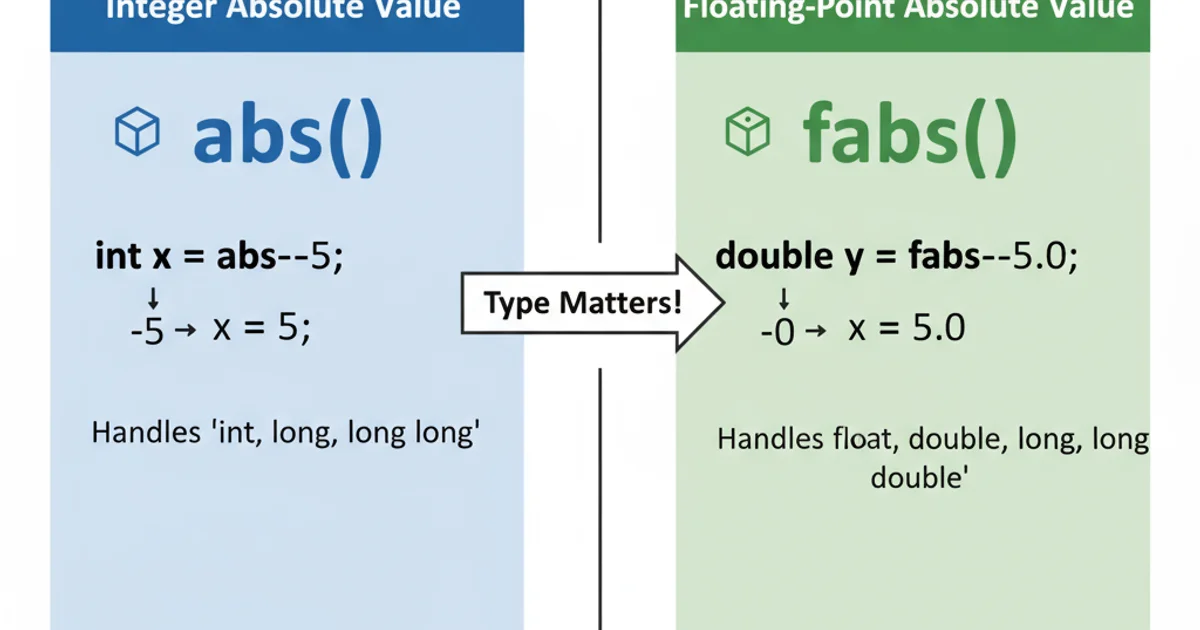What is "fabs" in Objective C?
Categories:
Understanding fabs in Objective-C: Absolute Values for Floating-Point Numbers

fabs is a standard C library function used in Objective-C to calculate the absolute value of floating-point numbers. This article explores its usage, importance, and common pitfalls.
In Objective-C development, especially when dealing with mathematical computations, you'll often encounter the need to work with absolute values. While integer types have a straightforward abs() function, floating-point numbers require a specialized approach. This is where fabs comes into play. Originating from the standard C library, fabs provides a reliable way to obtain the absolute magnitude of float, double, and long double types, ensuring your calculations remain accurate regardless of the number's sign.
What is fabs?
fabs is a function from the C standard library's <math.h> (or <cmath> in C++) that returns the absolute value of a floating-point argument. The absolute value of a number is its magnitude without regard to its sign. For example, the absolute value of -5.0 is 5.0, and the absolute value of 5.0 is also 5.0.
fabs is the primary function for double types, there are also fabsf for float and fabsl for long double to avoid implicit type conversions and potential precision loss, though fabs often handles these implicitly.Why Use fabs?
Using fabs is crucial for several reasons in numerical computations:
- Distance Calculations: When calculating the distance between two points or the difference between two values, the result should always be non-negative.
- Error Margins: In many algorithms, you might need to check if a value is within a certain error margin, irrespective of whether it's positive or negative.
- Normalization: Some mathematical operations or statistical analyses require input values to be positive.
- Comparison: Comparing the magnitude of two numbers without considering their signs.
flowchart TD
A[Input Floating-Point Number] --> B{Is Number < 0?}
B -- Yes --> C[Multiply by -1]
B -- No --> D[Return Number]
C --> D
D[Output Absolute Value]Conceptual flow of the fabs function
How to Use fabs in Objective-C
To use fabs in an Objective-C project, you typically need to import the <math.h> header. Once imported, you can call fabs with any floating-point variable or literal. The function will return a double type, so it's good practice to assign the result to a double variable or cast it if you need a float.
#import <Foundation/Foundation.h>
#import <math.h>
int main(int argc, const char * argv[]) {
@autoreleasepool {
double negativeValue = -123.45;
double positiveValue = 67.89;
float floatValue = -3.14f;
double absNegative = fabs(negativeValue);
double absPositive = fabs(positiveValue);
float absFloat = fabsf(floatValue); // Using fabsf for float
NSLog(@"Absolute value of %.2f is %.2f", negativeValue, absNegative);
NSLog(@"Absolute value of %.2f is %.2f", positiveValue, absPositive);
NSLog(@"Absolute value of %.2f is %.2f", floatValue, absFloat);
// Example with calculation
double diff = 10.5 - 20.7;
double absoluteDifference = fabs(diff);
NSLog(@"The absolute difference between 10.5 and 20.7 is %.2f", absoluteDifference);
}
return 0;
}
Example of using fabs and fabsf in Objective-C
fabs is part of the C standard library, Objective-C (being a superset of C) seamlessly integrates these functions. You don't need any special Objective-C syntax to use them.Common Pitfalls and Best Practices
While fabs is straightforward, keep these points in mind:
- Integer vs. Floating-Point: Remember to use
abs()for integers (int,long,long long) andfabs()(orfabsf/fabsl) for floating-point types. Usingabs()with adoublewill truncate the decimal part before calculating the absolute value, leading to incorrect results. - Header Inclusion: Always include
<math.h>to ensurefabsand related functions are properly declared and available. - Return Type:
fabsreturns adouble. If you're working exclusively withfloats, consider usingfabsfto maintain type consistency and potentially avoid minor performance overhead from type conversions. - NaN and Infinity:
fabshandles special floating-point values correctly.fabs(NaN)returnsNaN, andfabs(Infinity)returnsInfinity.

Distinguishing between abs() for integers and fabs() for floating-point numbers.